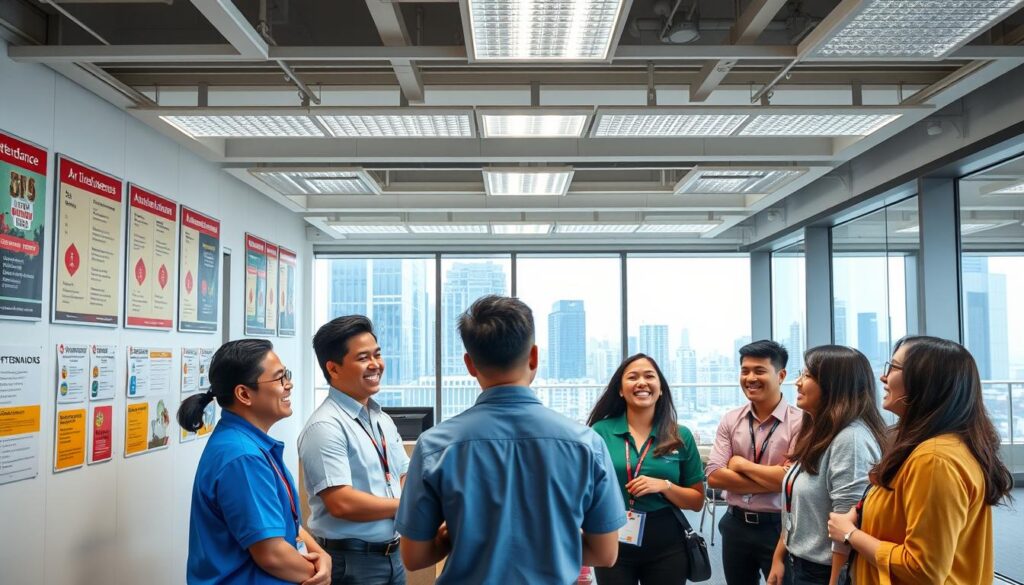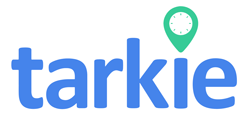Ever thought about how better attendance could boost your business? Punctuality and consistent attendance are key to success. In the Philippines, small and medium businesses see big gains from good attendance incentives.
These rewards programs are not just about being on time. They also boost morale and productivity. Let’s look at how you can use these incentives to make your team more dedicated and effective.
Key Takeaways
- Attendance significantly impacts productivity, quality, and customer satisfaction.
- Flexible work options can improve attendance rates in traditionally inflexible sectors.
- Recognition programs enhance employee motivation and engagement.
- Consistent attendance policies help set clear expectations, reducing issues over time.
- Involving employees in creating attendance solutions can increase commitment and ownership.
- Utilizing technology for tracking can streamline attendance management and boost compliance.
The Importance of Punctuality and Consistent Attendance
Punctuality and consistent attendance are key to a company’s success. Regular attendance helps teams work better together. It improves communication and builds a sense of shared goals.
When everyone is on time, the workplace feels more harmonious. This boosts team morale. But, if someone is always late, it can disrupt the whole team’s work.
Studies show that being on time is linked to being engaged at work. Employers see punctual workers as reliable and trustworthy. This can lead to more opportunities for them.
Being punctual is also seen as professional. It can affect who gets promoted. This shows how important being on time really is.
Tracking attendance is vital for managing these issues. Companies use technology to keep attendance consistent. This helps avoid wasting time on disciplinary actions.
By focusing on attendance, companies keep productivity high. Happy employees also make clients happier. This is a win-win for everyone.
Understanding Employee Motivation
Employee motivation is key to a happy and productive team. A motivated team works better and makes the workplace a better place. It’s about what makes employees happy and fulfilled, both inside and outside of work.
Recognition programs are a big help in keeping employees motivated. When we thank them for their hard work, they feel seen and valued. This makes them more likely to show up and do their best.
Performance rewards are another way to motivate employees. These can be money, extra time off, or chances to learn new skills. By rewarding good attendance and hard work, companies set a good example and encourage others to follow.
It’s also important to think about work-life balance and career growth. When employees feel appreciated and have opportunities to grow, they do better at work. They become more positive and supportive of their team and the company.

Types of Incentives for Employee Attendance
It’s important for companies to offer the right incentives for good attendance. Different incentives can motivate employees to show up on time and regularly. This can lead to better work and lower costs from missed days.
Both money and non-money rewards are key in making employees care about being on time.
Monetary Rewards
Monetary rewards include cash bonuses or attendance bonuses. These can really help get employees to come to work more. Companies say that giving out bonuses can make employees more committed, sometimes by up to 20%.
But, bonuses can cost a lot for employers.
A comparison of various monetary incentives is outlined in the table below:
| Type of Monetary Reward | Benefit | Cost |
|---|---|---|
| Attendance Bonuses | Increases attendance consistency | Higher overall payroll expenses |
| Performance Bonuses | Encourages daily punctuality | Potentially high payout |
| Cash Prizes for Lotteries | Engages employees through excitement | Variable costs based on prize amounts |
Non-monetary Rewards
Non-monetary rewards are often less expensive and can make employees happier. For example, recognizing top attenders can make others try harder. This can improve attendance by up to 10%.
Clear rules for recognition can also prevent jealousy among employees.
Effective non-monetary rewards can be many things:
- Public recognition in company meetings.
- Extra time off for perfect attendance.
- Monthly raffles for attendance rewards.
By choosing rewards that fit their culture, companies can make a better work place. This balance helps everyone.
How to Create an Effective Incentives Program
Creating a good incentive program starts with clear attendance goals. These goals should match the company’s big picture. They need to be specific and easy to track. For example, aiming for a certain number of perfect attendance days each month.
This makes it clear to employees what they need to do. It helps them stay motivated to hit those attendance goals.
Setting Clear Attendance Goals
Clear attendance goals guide employees. Companies can aim for targets every quarter or year. This keeps everyone focused on being there every day.
Checking in regularly lets managers see how things are going. They can give feedback to employees. This shows how important their role is in reaching these goals. Keeping everyone updated keeps the program exciting and clear.
Communicating Expectations
Good communication strategies are key. They make sure everyone knows what’s expected. Regular updates and open talks help avoid confusion.
Being open about how bonuses or rewards are given helps too. It shows employees exactly what they need to do. Using team meetings or online tools can make communication better. For tips on boosting productivity, check out this link.

Incentives, Punctuality, Employee Attendance: The Connection
Creating a strong link between incentives, punctuality, and employee attendance is key for any business aiming to thrive. By starting effective employee punctuality initiatives, a culture that values attendance can grow. When employees see their punctuality rewarded, they are more likely to arrive on time.
Companies with well-thought-out incentive programs see big improvements in attendance. By celebrating consistent effort, they lower absenteeism and boost employee dedication. Happy employees tend to be more reliable, leading to better productivity and morale.
Using good performance tracking helps managers spot attendance trends. This lets them tweak policies and incentives to meet employee needs. It’s a smart way to keep attendance high and work well.
Incentives do more than just improve attendance numbers. They make employees more engaged and motivated. This leads to better work efficiency. By focusing on a positive work atmosphere, companies can expect better attendance and success.
Best Practices for Implementing Attendance Incentive Programs
Starting attendance incentive programs needs a smart plan. It’s important to follow best practices to boost engagement and productivity. Making sure rules are followed clearly and fairly is key. Also, using good feedback systems helps create a culture where everyone knows what’s expected.
Consistency is Key
Keeping rules consistent helps avoid confusion and builds trust. When rules are followed regularly, employees know what’s expected of them. For example, companies that stick to their attendance policies see a 50% better response to these programs.
By being consistent, employees see the program as fair and motivating.
Feedback and Recognition
Recognizing employees is vital in encouraging good attendance. Regular feedback boosts morale and creates a better work place. Giving public recognition, like certificates, greatly improves engagement and job satisfaction.
Studies show that 80% of employees feel more motivated and loyal when recognized for their consistent attendance. Celebrating perfect attendance with non-monetary rewards can really boost team spirit and productivity.

Technology and Attendance Tracking
In today’s fast-paced work environment, using technology for attendance tracking is key. It helps organizations keep track of who’s in and who’s not. This modern approach makes it easier to monitor attendance and improve performance.
Utilizing Software Solutions
Using attendance tracking software can cut down on errors by up to 80%. This means more accurate records and a 25% boost in productivity. For those watching their budget, options like HiveDesk start at just $5/month per employee.
These systems save about 20 hours a month on paperwork. They can also cut down on absences by 30%. Many businesses struggle with attendance, but technology offers a solution.
These tools also help follow labor laws, avoiding fines of up to $1,000. They can reduce employee turnover by 15%, making the workplace more engaging. Biometric methods like fingerprint scanners cut down on fake attendance by up to 90%.
More companies are using mobile apps for attendance tracking, with a 50% growth expected soon. Self-service options make life easier for employees and HR, reducing their workload by 30%. Real-time alerts help manage issues quickly, improving compliance.
Advanced analytics reveal attendance patterns, helping spot and address issues. About 15% of employees might be responsible for half of all absences. Recognizing and rewarding on-time employees boosts morale and engagement by 10%.
Good attendance management leads to lower costs and better performance. It’s crucial for assessing employee commitment and reliability. For more on integrating attendance with payroll, check out this resource.
Addressing Attendance Challenges in the Workplace
Many companies face issues with employee attendance. It’s key to tackle these problems early to keep employees engaged and productive. Absenteeism can mess up workflows, raise costs, and lower morale. It’s important to understand why employees are missing work.
A clear attendance policy is vital. It sets clear expectations and helps manage attendance issues. It’s important to communicate openly with employees to find out why they’re missing work. This can help solve the root causes of absenteeism.
Flexible work options can help with attendance problems. For example, remote work or flexible hours can reduce absences. Using advanced timekeeping systems can also help track attendance accurately. Analyzing data can show how morale and engagement affect attendance.
It’s good to reward employees for good attendance. Bonuses and recognition can motivate them to be on time. Return-to-work interviews can also help understand why employees are absent. This can lead to better strategies to help them.
| Attendance Type | Impact on Business | Example Strategies |
|---|---|---|
| Scheduled Absences | Minimal disruption | Pre-approved vacation days |
| Unplanned Absences | Significant disruption | Flexible working arrangements |
| Unexcused Absences | Negatively affects morale | Formal counseling and support programs |
| Inconsistent Attendance | Increased workload stress | Documenting attendance issues & timely feedback |
By tackling attendance issues, companies can create a better work environment. These strategies can boost productivity, improve teamwork, and make the workplace healthier.
Examples of Effective Incentive Programs
Many Philippine companies have started using incentive programs to improve attendance and happiness at work. These success stories show how good plans can really change the workplace. They have made work places better and happier for everyone.
By recognizing good attendance, these companies have seen less people missing work. They also have a team that is more dedicated to their jobs.
Case Studies from Philippine Companies
Companies all over the Philippines have tried different ways to reward their employees. Here are some examples of how these strategies have worked:
| Company | Incentive Program | Results |
|---|---|---|
| Baumé Restaurant | Four-day workweek | Improved physical and mental health; decreased sick days |
| White Castle | ROCK contest | Sales increased by 89% in 90 days due to employee engagement |
| Visa | Prepaid incentive cards | Flexibility in rewards use, fostering employee satisfaction |
| HubSpot | Workplace flexibility initiatives | Engagement and satisfaction improved, leading to lower absenteeism |
| Local Retail Chain | Points-based reward system | Increased employee collaboration and goal achievement |
These stories show how special incentive programs can make a workplace better. Good programs create a culture that values being there and doing well. They make work more productive and build a team that cares more about their job.
Evaluating the Success of Your Incentive Program
Regularly checking how well your incentive programs work is key. By setting clear goals, you can see how well your efforts are paying off. This includes tracking attendance and seeing how it affects employee happiness.
Surveys can help you understand what your employees really think. They can share their true feelings about the program. This way, you can see what’s working and what needs a change.
Using tools to track attendance helps you understand why some employees might seem less involved. By focusing on what makes them happy, you can make your team more engaged. This leads to better work and higher productivity.
Changing your program based on what employees say keeps it fresh and effective. Regular checks help make sure it still meets your goals and what your team needs.

Conclusion
Incentives for attendance are key in creating a positive work culture. They show that being on time and engaged is important. By offering special rewards, companies can motivate their employees to do better.
Good attendance programs help employees feel more committed and perform well. This is very important, as absences can really disrupt work. It’s clear that incentives, employee engagement, and work dynamics are closely linked.
Having a clear attendance policy is also vital. It helps manage absences well. By addressing issues like conflicts and workload, companies can make their workplaces better.
Systems like Truein help track attendance fairly. They also help find out why people are absent. This makes the workplace fairer and more supportive.
In the end, a culture that values punctuality and commitment makes work better. With the right rewards, companies can reduce costs from absences. They also make their employees feel valued and connected, leading to success in the Philippines.
